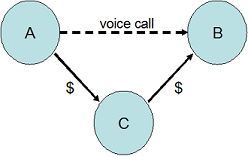April 29th, 2004
I know I haven’t been blog for more then a week…and nope, I havent disappear nor have I forgotten about this blog. I am just a little busy …
My day work involve dealing with people management, technologies, trials, planning my trips for APT-ITU IDN/ENUM Workshop in May and Supernova in June and writing papers, papers, papers. And my evening work involve taking care of my baby (my wife keep an interesting blog on the baby progress).
In between, I squeezed sometime playing with Gentoo and setting up MythTV (Damn! No XMLTV for Singapore which means more hacking to do), and setting up Asia Pacific ENUM Engineering Team (APEET), which we could no longer keep as a secret…(sorry, no info I can share yet)
Busy? Yes. Forgotten about this blog? No. :-)
Update: Kiat who has wandered into this blog has kindly email me with two source of XMLTV for Singapore: http://www.htpc-gear.com/epgdata.xml and http://www.geocities.com/chris.lupp/epg.html. If you know any others, please let me know!
April 16th, 2004
 One of my responsiblity at work involved identifying and monitoring disruptive technologies, especially infocomm technologies that will drastically change the economic, business and social landscape in Singapore. But what is disruptive technologies and how do you identify them?
One of my responsiblity at work involved identifying and monitoring disruptive technologies, especially infocomm technologies that will drastically change the economic, business and social landscape in Singapore. But what is disruptive technologies and how do you identify them?
 In the classic Crossing the Chasm, Geoff Moore describe a Technology Adoption Lifecycle Curve1. The curve is loosely divided into 5 segment: Innovators, Early Adoptors, Early Majority, Late Majority and lastly Laggers.
In the classic Crossing the Chasm, Geoff Moore describe a Technology Adoption Lifecycle Curve1. The curve is loosely divided into 5 segment: Innovators, Early Adoptors, Early Majority, Late Majority and lastly Laggers.
More interesting, the area under the curve can be interpreted as the User Expections from the technology. And the more mature the technology, the higher the user expections. The laggers remains is the most difficult customers that often requiring the most resources and thus, most companies adopt the 80/20 rule.
Read the rest of this entry »
April 15th, 2004
Today mark the publication of RFC 3743. aka JET IDN Guideline. A work I started in the Joint Engineering Team (JET) after realizing that it is not possible to handle traditional and simplified ideographs within the IDN protocol in 2001. To certain extend, ICANN’s Guideline for IDN is based on this work.
Phew..it been a long journey (my god..more then 2 years!) and I am glad I can put this behind. This work would not be done without the assistant of John Klensin. Thanks all!
ps: This is not Standard Track. It is an Informational RFC.
April 9th, 2004
ICANN is seeking comments about the 10 new sponsored TLDs (via Paul Hoffman). Let me give my five cent worth:
First, the evaluation of sponsored TLDs should be based on the appropriateness of sponsors1. Whether it is ‘useful’ or ‘useless’ to the Internet shouldn’t be a factor since one’s rubbish is another gem. This is one of the things I learnt working for an open-minded regulator, that one should not think they are smart enough to pick market winners.
Of course, the proposed TLD should not cause “harm” to the Internet. Any TLDs which fails this test should not be allowed to proceed. But it is easy to confuse “harmful” with “useless” so we must be careful.
1. .asia — ah, my fav, one that made me some enemies2 because of my vocal opposition. The problem with this proposal is that it fails the “appropriateness of sponsors” test. The word ASIA is as significant as EU and it is unimagable that some NGOs, NPOs and commerical entities3 are sufficient to be the “sponsor” for .ASIA. This isn’t the same as .EU where it has EC behind it. There is no government representation and neither has this been discussed at any government-to-government meetings like APEC TEL or APT or AP MinTel etc. With the recent development at WSIS, I don’t think ICANN should setup a timebomb for itself. Recommendation: request more governmental support for this TLD.
Read the rest of this entry »
April 7th, 2004
I have a very interesting dinner last night with Michael Robertson and Jeff Bonforte, CEO and President of SIPPhone.com respectively. Most people will know Michael as the founder of MP3.com and Lindows. They are in town for their big announcement with Singtel. (Yes, 1-747-xxx-xxxx will be routed from Singapore soon :-)
It is a social dinner hosted by Richard Tan (Singtel) and we talk about life, travel, lobsters, basketballs and kids1. Of course, we also talk about cool SIP gadgets and ENUM. :-)
Read the rest of this entry »
April 5th, 2004
 Took me quite a few weekends but I finally ported my mails on a (Courier) IMAP server with Qmail, Spamassassin and TMDA. (anti-virus not up yet tho…).
Took me quite a few weekends but I finally ported my mails on a (Courier) IMAP server with Qmail, Spamassassin and TMDA. (anti-virus not up yet tho…).
It feels damn good to know I can access 5 years of e-mail on any machines and devices: from my desktop, my notebooks, powerbook and even my Sharp Zaurus! Whee!
April 4th, 2004
I really really wish I am now at WTF2004, a gathering of S.M.A.R.T people. I am missing out all the fun :-(
But in anycase, I participated virtually and have tuned in a few session tonight. The audio keep breaking up but I managed to get some piece of it here.
Of interest is Eli Noam arguing that Information Industry is essentially an unstable industry! Wow…
My first reaction is totally denial…how can it be!? But as I think about it, perhaps it has some valid arguments that need to investigate further.
Read the rest of this entry »
April 3rd, 2004
 A friend email me asking why ITU-T SG3 is not suitable to handle the issues of Internet Peering. He pointed out that while there are technology differences, the economics and policies should be fairly similar given they are both bilteral arrangement. I beg to differ.
A friend email me asking why ITU-T SG3 is not suitable to handle the issues of Internet Peering. He pointed out that while there are technology differences, the economics and policies should be fairly similar given they are both bilteral arrangement. I beg to differ.
Lets take a detour: When User 1 on carrier A (origination carrier) makes a phone call to User 2 on Carrier B (termination carrier), the usual financial arrangement is the A will pays a termination fee to the B. And in the case where A and B don’t have direct connection but are connected via Carrier C, then A will redirect its call to C (A pays C) and C will reroute the call to B (and then C will pay A B). This is how it works in a nutshell1.
Fairly simple and striaght forward because we are dealing with one and only one application: Voice2.
Read the rest of this entry »
April 1st, 2004
I have a long breakfast with Patrick Gannon, CEO of OASIS regarding the progress made by the FWSI TC or Framework for Web Services Implementation1 Technical Committee.
Both of us are have high hopes for TC. You see, if WS is to be the become the infrastructure-platform where machine-to-machine communicates to each another, then what it also need are common APIs or building blocks where programmers can utilizes without replicating for each application. A simple anlogy is if WS is the network-OS, then FWSI is the libc/POSIX.
Read the rest of this entry »






 Took me quite a few weekends but I finally ported my mails on a (
Took me quite a few weekends but I finally ported my mails on a (
